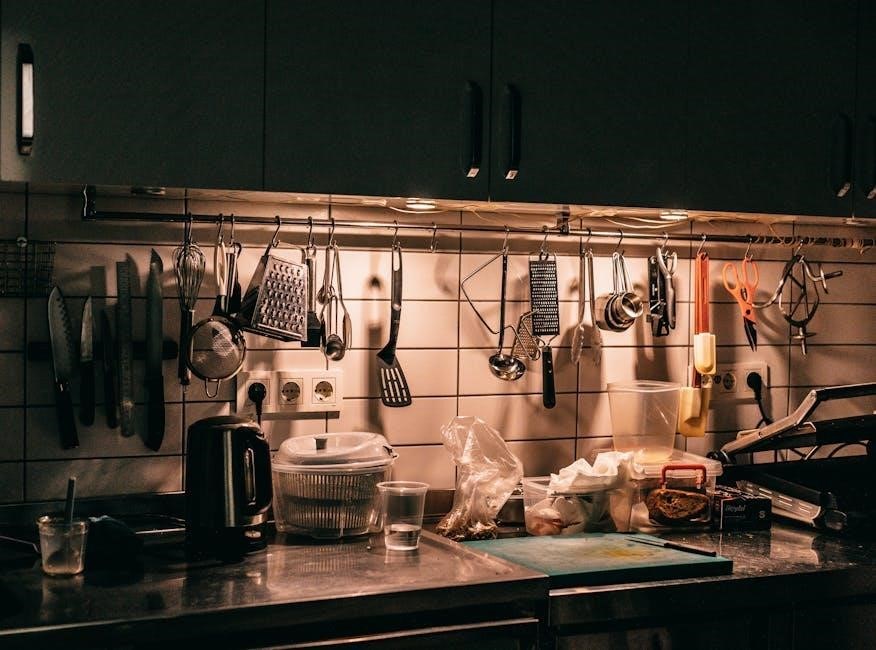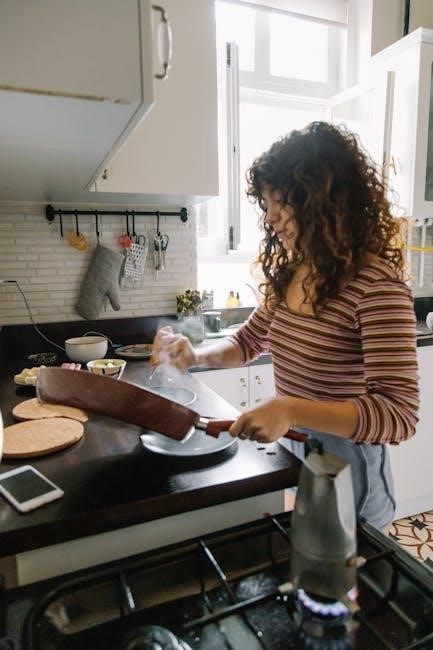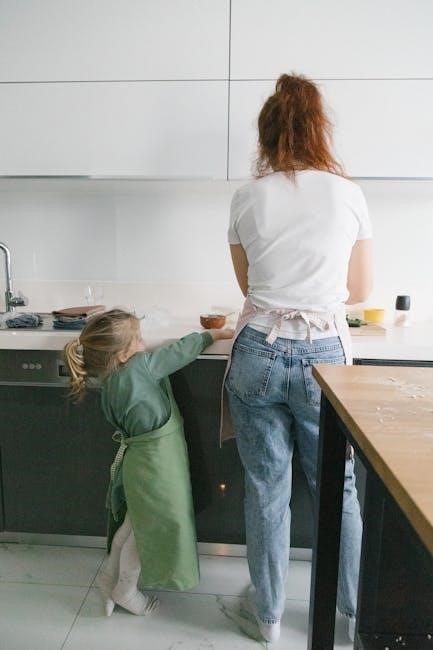jennie o turkey cooking instructions

jennie o turkey cooking instructions
Discover the ease of cooking with Jennie-O turkey products, perfect for any occasion. Follow these simple, step-by-step instructions to achieve delicious, safe, and stress-free results every time.
1.1 Overview of Jennie O Turkey Products
Jennie-O offers a variety of convenient turkey products, including whole turkeys, turkey breasts, and oven-ready options. Their products are designed to simplify cooking while ensuring flavorful results. From classic whole turkeys to boneless, skinless breasts, Jennie-O caters to diverse preferences and cooking methods. Many products are pre-seasoned or prepped for easy preparation, making them ideal for both novice and experienced cooks. Whether roasting, grilling, or slow-cooking, Jennie-O provides options to suit every meal.
1.2 Importance of Proper Cooking Techniques
Proper cooking techniques are essential for achieving a safe and deliciously cooked turkey. Ensuring the turkey reaches the recommended internal temperature of 165°F for the breast and 180°F for the thigh is critical to prevent undercooking. Improper methods can lead to foodborne illness or an overcooked, dry turkey. Following guidelines ensures even browning, juicy meat, and a flavorful result, making your meal both safe and enjoyable for everyone.

Thawing Instructions for Jennie O Turkey
Thawing a Jennie-O turkey ensures even cooking and food safety. Use the refrigerator method for 3-4 days or cold water thawing for a quicker option. Proper thawing is essential for achieving the best results.
2.1 Refrigerator Thawing Method
For the refrigerator thawing method, place the Jennie-O turkey in a leak-proof bag or wrap it tightly in plastic wrap. Store it on the middle or bottom shelf of the refrigerator at a consistent temperature of 40°F or below. Allow about 3-4 days for a whole turkey to thaw completely. This method ensures slow, safe thawing and prevents bacterial growth. Once thawed, cook the turkey within 2 days for optimal freshness.
2.2 Cold Water Thawing Method
For the cold water thawing method, submerge the Jennie-O turkey in a leak-proof bag in cold water. Change the water every 30 minutes to maintain safety. Allow about 30 minutes per pound to thaw. This method is faster than refrigerator thawing but requires consistent monitoring. Once thawed, cook the turkey immediately to ensure food safety and prevent bacterial growth. Always keep the water cold to avoid contamination risks.
Preparing the Turkey for Cooking
Preheat your oven to 325°F and place the Jennie-O turkey on a rack in a shallow pan, skin side up. This ensures even cooking and browning.
3.1 Preheating the Oven to 325°F
Preheating your oven to 325°F is essential for even cooking. Place the Jennie-O turkey on a rack in a shallow pan, skin side up, and loosely cover with foil. This setup promotes air circulation and prevents over-browning. Ensure the oven is fully preheated before placing the turkey inside for optimal results. Proper preheating ensures the turkey cooks evenly and safely, reaching the required internal temperature without hot spots.
3.2 Placing the Turkey on a Rack in a Shallow Pan
Place the Jennie-O turkey breast side up on a rack in a shallow roasting pan. This allows air to circulate evenly under the turkey, ensuring uniform cooking and preventing the bottom from steaming. The rack also helps the turkey brown evenly and prevents it from sticking to the pan. Positioning the turkey this way promotes crisp skin and a juicy interior. Always follow the manufacturer’s guidelines for pan size and rack placement.

Cooking Times and Temperatures
Cooking times vary based on turkey size. Ensure internal temperatures reach 165°F for the breast and 180°F for the thigh for safe consumption. Roasting times range from 8-24 pounds.
4.1 Internal Temperature Requirements (165°F for Breast, 180°F for Thigh)
The internal temperature of the turkey is crucial for food safety. Use a meat thermometer to ensure the breast reaches 165°F and the thigh reaches 180°F. Insert the thermometer into the thickest part of the breast, avoiding bones or fat. For the thigh, place it in the thickest area, avoiding the bone. Always check both areas to confirm doneness. The temperature rises rapidly in the final stages of cooking, so monitor closely to prevent overcooking.
4.2 Approximate Oven Roasting Times (8-24 Pounds)
For an 8-12 pound turkey, roast for 3-4 hours. A 12-18 pound turkey needs 4-4.5 hours, while an 18-22 pound turkey requires 4.5-5 hours. A 22-24 pound turkey cooks in 5-5.5 hours, all at 325°F. These times ensure even cooking and safety. Always use a meat thermometer to confirm internal temperatures, as oven variations may affect cooking duration. Adjust times slightly for stuffed turkeys, ensuring the stuffing reaches 165°F.

Stuffing and Cooking Safety
Cook stuffing separately for optimal food safety. Use a food-safe temperature of 165°F. Avoid undercooked stuffing to prevent foodborne illness and ensure a safe, enjoyable meal.
5.1 Cooking Stuffing Separately for Optimal Safety
Cooking stuffing separately ensures food safety and prevents undercooked areas. Heat it to an internal temperature of 165°F to eliminate harmful bacteria. This method avoids cross-contamination risks associated with cooking stuffing inside the turkey. Always use a food thermometer to confirm doneness for a safe and enjoyable meal.
5.2 Adding Cooked Stuffing to the Turkey Before Serving
For a traditional presentation, add fully cooked stuffing to the turkey cavity just before serving. Ensure the stuffing reaches 165°F internally for safety. Gently fill the turkey loosely to avoid overcrowding, which can harbor bacteria. Garnish with fresh herbs if desired. Keep the turkey hot and serve immediately to maintain food safety and enjoy a flavorful, well-presented meal.
Browning the Turkey
Remove foil during the last hour of cooking to allow the turkey to brown evenly, enhancing its golden appearance and flavor for a perfect presentation.
6.1 Removing Foil for Browning
Remove the foil during the last hour of cooking to allow the turkey to brown evenly. Carefully cut the foil in an X shape on top and peel it back to expose the skin. This step enhances the turkey’s golden appearance and flavor. Ensure the internal temperature reaches 165°F for the breast and 180°F for the thigh before serving; Monitor closely to avoid over-browning and achieve a perfectly cooked turkey.
6.2 Ensuring Even Browning
To achieve even browning, rotate the turkey halfway through the cooking time. Use a rack in a shallow pan to promote air circulation and prevent uneven cooking. Avoid overcrowding the pan, as this can hinder browning. If needed, baste the turkey with pan juices to enhance color and moisture. Always monitor the turkey closely during the browning phase to ensure a golden, evenly cooked finish without overcooking.
Using a Meat Thermometer
Insert the thermometer into the thickest part of the breast and thigh, avoiding bones. Ensure the internal temperature reaches 165°F for the breast and 180°F for the thigh.
7.1 Inserting the Thermometer in the Thickest Part of the Breast
Insert the meat thermometer into the thickest part of the breast, avoiding any bones or fat. This ensures an accurate reading of the internal temperature, which should reach 165°F for safety. Place the thermometer before cooking or during the last hour of cooking. Proper placement guarantees even cooking and prevents undercooking. Always check multiple spots to ensure consistency and doneness throughout the turkey breast.
7.2 Monitoring Temperature During Cooking
Monitor the turkey’s internal temperature closely, especially during the last hour of cooking, as it can rise rapidly. Use a meat thermometer to ensure the breast reaches 165°F and the thigh reaches 180°F. Check the temperature frequently without overchecking, as this can disrupt even cooking. Proper monitoring prevents undercooking or overcooking, ensuring a safe and juicy turkey. This step is crucial for achieving the perfect doneness every time.

Alternative Cooking Methods
Explore alternative methods like slow cooking. Place the turkey in a slow cooker on HIGH for 4 hours or LOW for 8 hours. Achieve tender results effortlessly with these convenient options.
8.1 Slow Cooker Instructions (HIGH Setting: 4 Hours, LOW Setting: 8 Hours)
For a hands-off approach, place the turkey in a slow cooker. On HIGH, cook for 4 hours, or on LOW for 8 hours. Ensure the turkey reaches an internal temperature of 165°F to 180°F for safety. This method yields tender, evenly cooked meat with minimal effort. Monitor the temperature during the last hour to avoid overcooking. Perfect for busy days, this option delivers delicious results with hassle-free preparation.
Oven Ready Turkey Breast Instructions
Cook Jennie-O Oven Ready Turkey Breast directly from frozen at 375°F. Place in oven, leaving the inner cooking bag intact. No thawing required for convenience.
9.1 Preheating the Oven to 375°F
Preheating your oven to 375°F is essential for cooking Jennie-O Oven Ready Turkey Breast. Ensure the oven reaches this temperature before placing the turkey inside. This step guarantees even cooking and food safety. Remember, the turkey can be cooked directly from frozen, so no thawing is needed. Always verify the oven temperature using a thermometer for accuracy. Proper preheating ensures the turkey cooks evenly and safely.
9.2 Cooking Directly from Frozen
Cooking a Jennie-O Oven Ready Turkey Breast directly from frozen is convenient and stress-free. Simply place the turkey in the oven at 375°F as directed. Do not remove the inner cooking bag, as it ensures even cooking and prevents drying. Roast until the internal temperature reaches 165°F. This method guarantees a perfectly cooked turkey without the need for thawing, saving time while maintaining safety and flavor.

Serving the Turkey
Letting your Jennie-O turkey rest before carving ensures juicy, tender meat. Allow it to sit for 20-30 minutes, then carve thinly and serve perfectly for the best results.
10.1 Letting the Turkey Rest Before Carving
Allowing the turkey to rest is crucial for retaining juices and flavor. After cooking, cover it loosely with foil and let it sit for 20-30 minutes. This allows the internal temperature to even out, ensuring tender meat. Cutting too soon can release juices, making the turkey dry. Use this time to prepare sides or gravy before carving and serving your perfectly rested Jennie-O turkey.

Additional Tips and Resources
For a perfect Jennie-O turkey, use a meat thermometer, ensure safe handling, and visit the Jennie-O website for detailed guides, videos, and recipe ideas to enhance your cooking experience.
11.1 Checking for Doneness
Ensuring your Jennie-O turkey is cooked to a safe internal temperature is crucial. Use a meat thermometer to check the thickest part of the breast, aiming for 165°F, and the thigh, targeting 180°F. Avoid touching bones or fat with the probe for accurate readings. Always verify doneness in multiple areas to ensure even cooking. Remember, internal temperature can rise rapidly during the final hour of cooking. For the most accurate results, never rely solely on cooking time estimates.
11.2 Accessing Detailed Instructions Online
For comprehensive guides, visit the Jennie-O official website, which offers detailed cooking instructions, videos, and product-specific guides. Their resources include step-by-step tutorials, temperature charts, and troubleshooting tips. Whether you’re cooking a whole turkey or a breast, their online platform ensures you have everything needed for a perfectly cooked meal. Use the provided link: https://bddy.me/3Fv4qro for quick access.
Mastering Jennie-O turkey cooking is simple with proper thawing, safe internal temperatures, and browning techniques. Follow these steps for a delicious, perfectly cooked turkey every time.
12.1 Summary of Key Cooking Steps
- Thaw the turkey in the refrigerator or cold water for safe preparation.
- Preheat the oven to 325°F and place the turkey on a rack in a shallow pan.
- Cook until the internal temperature reaches 165°F for the breast and 180°F for the thigh.
- Use a meat thermometer to ensure doneness and monitor temperature during cooking.
- For browning, remove foil and allow the turkey to brown evenly.
- Let the turkey rest before carving for juices to redistribute.